#ContentPromotion
Text
YouTube Video SEO with Organic Promotion
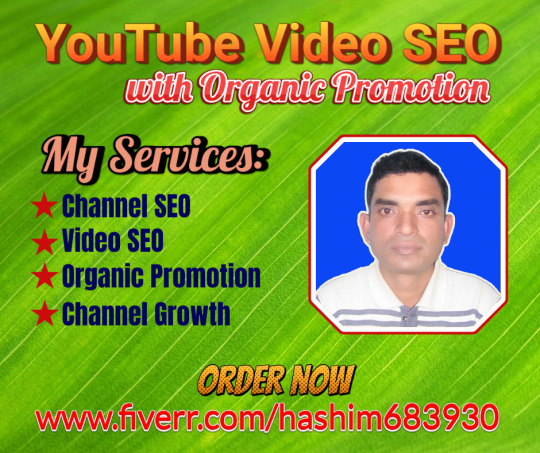
Hello Dear!
Are you starting a YouTube channel and want to attract potential clients to grow your targeted audience organically? You should do YouTube video SEO with certain keywords and organic promotion for your channel and videos to grow to attract potential audiences organically. I'm an S-E-O Expert and Promoter.
My Service Description:
YouTube Video SEO with Organic Promotion
SEO-friendly video Title, Description, and Keyword settings
On page-off page s-eo
Increasing Actionable and Performance score
Add Card, End Screen, Closed Caption, and Playlist
Replied to a recent comment
High Volume Ranked Tag Use
Playlist Create
Channel growth organically
Channel and Video Research
Keyword and Hashtag Research
Improving SEO score by vidIQ
Niche-related keyword settings
Service Specialty:
100% Safe and Organic Promotion
Provide Work Proof Report
Long experience with multiple clients
For More Info, Visit and Order Now
#youtubevideoseo#YouTubeSEO#VideoMarketing#OrganicPromotion#YouTubePromotion#SEOtips#YouTubeStrategy#DigitalMarketing#ContentStrategy#VideoSEO#OnlineMarketing#YouTubeChannel#YouTubeOptimization#SearchEngineOptimization#VideoPromotion#ContentPromotion#SocialMediaMarketing#YouTubeAlgorithm#DigitalStrategy#ContentMarketing#YouTubeGrowth#VideoOptimization#fiverr#fiverrseller#onlineseller#youtube#youtuber#freelancer#freelancing
2 notes
·
View notes
Text
Measuring the Success of Your Content Marketing Strategy: Key Metrics to Monitor
Content marketing is a crucial component of any business’s overall marketing strategy. It involves creating and distributing valuable, relevant, and consistent content to attract and engage a specific target audience. The goal of content marketing is to drive profitable customer action by building a relationship with potential customers and providing them with the information they need to make informed purchasing decisions.

Measuring the success of your content marketing strategy is essential to determining whether your efforts are paying off and making the necessary adjustments to improve your results. Here are some key metrics to measure the success of your content marketing strategy:
Traffic: One of the most basic metrics to measure the success of your content marketing strategy is the amount of traffic your website receives. This includes the number of visitors to your website, the pages they visit, and the time they spend on your site.
Engagement: Engagement metrics measure how engaged your audience is with your content. This includes the number of likes, shares, comments, and views on your content. Engagement metrics are important because they indicate how well your content is resonating with your audience and whether it is inspiring them to take action.
Lead generation: Lead generation metrics measure how well your content is converting visitors into leads. This includes the number of form submissions, email sign-ups, and phone calls generated by your content. Lead generation metrics are important because they indicate how well your content is attracting potential customers and how well it is converting them into leads.
Sales: Sales metrics measure how well your content is converting leads into customers. This includes the number of sales generated by your content and the revenue generated by those sales. Sales metrics are important because they indicate how well your content is performing in terms of driving profitable customer action.
ROI: Return on Investment (ROI) is a metric that measures the return on your investment in content marketing. This includes the cost of creating and distributing your content, as well as the revenue generated by your content. ROI metrics are important because they indicate how well your content is performing in terms of driving profitable customer action.
Measuring the success of your content marketing strategy is essential to determining whether your efforts are paying off and making the necessary adjustments to improve your results. By monitoring and analyzing these key metrics, you can gain valuable insight into the effectiveness of your content marketing strategy and make data-driven decisions to improve your results.
In conclusion, content marketing is a crucial component of any business’s overall marketing strategy. Measuring the success of your content marketing strategy is essential to determining whether your efforts are paying off and making the necessary adjustments to improve your results. By monitoring and analyzing key metrics such as traffic, engagement, lead generation, sales, and ROI, you can gain valuable insight into the effectiveness of your content marketing strategy and make data-driven decisions to improve your results.
#ContentMarketingTactics#ContentCreationTips#ContentStrategySuccess#MarketingPlanning#ContentPromotion#TargetAudienceEngagement#ContentMarketingGoals#BuildingBrandAwareness#ContentOptimization#MeasuringContentSuccess
8 notes
·
View notes
Text
The Power of Storytelling in Your Content Marketing Efforts
Storytelling has long been a powerful tool for human communication and connection. From ancient cave paintings to modern day films and books, stories have the ability to transport us to different worlds and connect us with characters and emotions in ways that simple facts and statistics never could. This same power can be harnessed in content marketing efforts, allowing businesses to connect with their audience on a deeper level and ultimately drive more conversions and sales.

One of the key benefits of using storytelling in content marketing is that it helps to build a strong emotional connection with the audience. People are naturally drawn to stories and can relate to the characters and experiences described in them. By incorporating storytelling into your content marketing efforts, you can create a deeper, more meaningful connection with your audience and make them more likely to engage with your brand and products.
Another benefit of storytelling in content marketing is that it can help to differentiate your brand from your competitors. In today's crowded digital landscape, it can be difficult to stand out and grab the attention of your target audience. By telling unique and engaging stories, you can differentiate your brand and make it more memorable to your audience. This can be especially useful for small businesses and startups looking to establish themselves in a crowded market.
Storytelling can also be used to educate and inform your audience about your products or services. By using stories to demonstrate the benefits of your products or services, you can help to build trust and credibility with your audience. This can be especially useful for businesses in industries such as healthcare or finance, where trust and credibility are crucial to success.
In order to effectively use storytelling in your content marketing efforts, it is important to keep a few key things in mind. First, make sure that your story is relevant and interesting to your target audience. This means understanding their pain points and interests, and tailoring your story to speak directly to them. Secondly, keep your story simple and easy to follow, using clear and concise language to ensure that your message is easily understood. Finally, use storytelling throughout your content marketing efforts, from blog posts and social media updates to email campaigns and video content.
In conclusion, storytelling is a powerful tool that can be used to enhance your content marketing efforts. By building emotional connections with your audience, differentiating your brand, and educating and informing your audience about your products or services, storytelling can help to drive more conversions and sales for your business. So, if you want to take your content marketing efforts to the next level, start incorporating storytelling into your strategy today.
#ContentMarketingTactics#ContentCreationTips#ContentStrategySuccess#MarketingPlanning#ContentPromotion#TargetAudienceEngagement#ContentMarketingGoals#BuildingBrandAwareness#ContentOptimization#MeasuringContentSuccess
12 notes
·
View notes
Text
The Role of SEO in Your Content Marketing Strategy
Search engine optimization (SEO) is a vital aspect of any content marketing strategy. It helps to ensure that your content is easily discoverable by your target audience, and that it ranks well in search engine results pages (SERPs).

When it comes to SEO, there are a number of factors to consider. One of the most important is keyword research. This involves identifying the keywords and phrases that your target audience is likely to use when searching for the types of products or services that you offer. Once you have a list of keywords, you can then optimize your content to include these keywords in the title, meta description, and body of your content.
Another important aspect of SEO is link building. This refers to the process of acquiring links from other websites that point to your own. The more high-quality links you have pointing to your website, the more likely it is to rank well in search engine results. This can be achieved by creating high-quality content that other websites will want to link to, as well as by reaching out to other websites and asking them to link to your content.
In addition to keyword research and link building, there are a number of other SEO tactics that you can use to improve the visibility of your content. These include optimizing images, using header tags, and ensuring that your website is mobile-friendly.
One of the most important things to keep in mind when it comes to SEO is that it is an ongoing process. This means that you will need to regularly update your content, as well as monitor your website's analytics to see how your content is performing. Additionally, you will need to stay up-to-date with the latest SEO trends and best practices, as search engine algorithms are constantly evolving.
Overall, SEO plays a crucial role in any content marketing strategy. By optimizing your content for search engines, you can increase its visibility and reach a wider audience. However, it's important to remember that SEO is just one piece of the puzzle, and that a comprehensive content marketing strategy should also include elements such as social media marketing, email marketing, and influencer marketing.
In conclusion, SEO is a significant aspect in content marketing strategy, it's a process that requires constant monitoring and updating, it's not only about keyword research and link building but also optimizing images, using header tags, and ensuring mobile-friendliness. SEO is just one piece of the puzzle, and a comprehensive content marketing strategy should also include elements such as social media marketing, email marketing, and influencer marketing. To be successful with SEO, it's essential to keep up-to-date with the latest SEO trends and best practices, as search engine algorithms are constantly evolving.
#ContentMarketingTactics#ContentCreationTips#ContentStrategySuccess#MarketingPlanning#ContentPromotion#TargetAudienceEngagement#ContentMarketingGoals#BuildingBrandAwareness#ContentOptimization#MeasuringContentSuccess
8 notes
·
View notes
Text
Content Marketing on a Budget: How to Maximize Your Efforts with Limited Resources

Content marketing can be a powerful tool for businesses looking to connect with their target audience and promote their products or services. However, creating high-quality content can be a time-consuming and expensive process. For businesses with limited resources, it can be challenging to create a content marketing strategy that is both effective and affordable.
One of the key ways to maximize your content marketing efforts on a budget is to focus on creating high-quality, evergreen content. Evergreen content is content that remains relevant and useful over time, as opposed to content that is time-sensitive or tied to a specific event. By creating evergreen content, you can ensure that your content will continue to drive traffic and generate leads for your business long after it is published.
Another way to maximize your content marketing efforts on a budget is to repurpose your existing content. This can include updating older blog posts, creating new content based on existing content, or republishing your content on different platforms. By repurposing your content, you can save time and resources while still reaching a wide audience.
You can also make use of social media platforms to promote your content. Social media platforms like Facebook, Instagram, and Twitter are great places to share your content and reach a wider audience. By creating a social media strategy and consistently posting your content, you can increase your visibility and reach without spending a lot of money.
Another budget-friendly approach is to collaborate with other businesses or influencers in your industry. Partnering with other businesses or influencers can help you reach a wider audience and increase your visibility. By working together, you can share resources and create content that benefits both parties.
In conclusion, creating a content marketing strategy on a budget can be challenging, but it is not impossible. By focusing on evergreen content, repurposing your existing content, making use of social media platforms, and collaborating with other businesses or influencers, you can maximize your content marketing efforts and reach your target audience without breaking the bank. It is important to remember that the most important thing is to create valuable content that resonates with your target audience, regardless of the budget.
#ContentMarketingTactics#ContentCreationTips#ContentStrategySuccess#MarketingPlanning#ContentPromotion#TargetAudienceEngagement#ContentMarketingGoals#BuildingBrandAwareness#ContentOptimization#MeasuringContentSuccess
10 notes
·
View notes
Text
How to Create a Content Marketing Plan that Drives Results
Creating a content marketing plan that drives results is essential for any business looking to build a strong online presence and attract new customers. A well-thought-out plan will not only help you to define your target audience and goals, but it will also ensure that your content is tailored to their needs and interests. Here are a few steps to help you create a content marketing plan that drives results.

Step 1: Define Your Target Audience
The first step in creating a content marketing plan is to define your target audience. This will help you to understand who your ideal customer is and what their needs and interests are. You should consider factors such as age, gender, income, and location, as well as their pain points and goals. Once you have a clear understanding of your target audience, you can tailor your content to meet their specific needs.
Step 2: Set Clear Goals
The next step is to set clear goals for your content marketing plan. These goals should be specific, measurable, achievable, relevant, and time-bound (SMART). For example, you may want to increase website traffic by 20% over the next quarter, or generate a certain number of leads through your blog. Setting clear goals will help you to measure the success of your content marketing plan and make adjustments as needed.
Step 3: Create a Content Calendar
Once you have defined your target audience and set clear goals, it's time to create a content calendar. This is a schedule of when and where you will publish your content, and it should align with your goals and target audience. You should also consider the different types of content you will create, such as blog posts, videos, infographics, and social media updates. A content calendar will help you to stay organized and ensure that you are consistently creating and publishing relevant content.
Step 4: Optimize for Search Engines
To ensure that your content is easily discoverable by your target audience, it's important to optimize it for search engines. This includes including keywords in your content, creating meta tags, and using alt tags for images. This will help your content to rank higher in search engine results, making it more likely to be seen by your target audience.
Step 5: Measure and Analyze Results
The final step in creating a content marketing plan that drives results is to measure and analyze the success of your efforts. This includes tracking metrics such as website traffic, engagement, and conversions. Analyzing these metrics will help you to understand what is working and what isn't, and make adjustments as needed.
Creating a content marketing plan that drives results takes time and effort, but it's worth it in the end. By following these steps, you can ensure that your content is tailored to your target audience and that it helps you to achieve your goals. Remember to always measure and analyze your results, and make adjustments as needed. With a solid content marketing plan, you can build a strong online presence and attract new customers.
#ContentMarketingTactics#ContentCreationTips#ContentStrategySuccess#MarketingPlanning#ContentPromotion#TargetAudienceEngagement#ContentMarketingGoals#BuildingBrandAwareness#ContentOptimization#MeasuringContentSuccess
7 notes
·
View notes
Text
The Future of Content Marketing: Trends and Predictions
Content marketing has been a vital aspect of digital marketing for years, and it shows no signs of slowing down. As technology and consumer behavior continue to evolve, so too must the strategies and tactics used in content marketing. In this article, we will explore some of the key trends and predictions for the future of content marketing.

One trend that is already taking shape is the increased focus on personalized content. With so much information available online, consumers are becoming more discerning about the content they consume. They are looking for content that is tailored to their interests and needs. As a result, businesses must be more strategic in their content creation, ensuring that they are providing valuable and relevant information to their target audience.
Another trend that is expected to gain traction in the future is the use of artificial intelligence (AI) in content marketing. AI-powered tools can be used to analyze data and create personalized content, as well as to measure the effectiveness of marketing campaigns. Additionally, AI-powered chatbots and virtual assistants can be used to engage with customers and provide them with the information they need in real-time.
Video content is also expected to play a bigger role in the future of content marketing. With the rise of platforms like YouTube and TikTok, video is becoming one of the most popular forms of content online. Businesses can use video to showcase their products and services, tell their brand story, and even provide educational content.
Social media is also expected to continue to be a key component of content marketing. As more and more people are spending time on social media, businesses must ensure that their content is optimized for these platforms. They should also look to use social media influencers to reach new audiences and increase brand awareness.
Finally, the future of content marketing is predicted to be more interactive and engaging. With the rise of virtual and augmented reality, businesses will be able to create immersive experiences for their customers that will help them to better understand their products and services. Additionally, interactive content such as quizzes, polls, and surveys will be used to engage with customers and gather valuable data.
In conclusion, the future of content marketing is expected to be more personalized, data-driven, and interactive. Businesses must stay ahead of the curve by using new technologies such as AI and virtual reality, and focus on creating valuable and relevant content that will engage their target audience. By doing so, they can build trust and loyalty with their customers and ensure their long-term success.
#ContentMarketingTactics#ContentCreationTips#ContentStrategySuccess#MarketingPlanning#ContentPromotion#TargetAudienceEngagement#ContentMarketingGoals#BuildingBrandAwareness#ContentOptimization#MeasuringContentSuccess
3 notes
·
View notes
Text
Creating a Content Marketing Strategy: A Beginner's Guide
Creating a content marketing strategy can seem daunting, especially for beginners. However, with a little bit of planning and a clear understanding of your audience and goals, you can develop a content marketing strategy that drives results for your business.
The first step in creating a content marketing strategy is to define your target audience. Who are you trying to reach with your content? What are their needs and pain points? Understanding your audience will help you create content that speaks directly to them and addresses their specific concerns.
Once you have a clear understanding of your target audience, you can begin to define your content marketing goals. What do you hope to achieve with your content? Are you looking to increase brand awareness, generate leads, or drive sales? Having clear goals in mind will help you create content that is aligned with your business objectives.
Next, you will want to develop a content calendar. This will help you plan and schedule your content in advance, ensuring that you are consistently publishing new content and engaging with your audience. When creating your content calendar, consider the different types of content that you will be creating, such as blog posts, social media updates, videos, and infographics.
It's also important to consider the different stages of the buyer's journey when creating your content. The buyer's journey refers to the different stages that a potential customer goes through when considering a purchase, such as awareness, consideration, and decision. Your content should address the specific needs and concerns of your audience at each stage of the buyer's journey.
Once you have a solid content marketing strategy in place, it's important to consistently measure and analyze your results. This will help you understand what is working and what is not, and make adjustments as needed. Some key metrics to track include website traffic, engagement rates, lead generation, and conversions.
In conclusion, creating a content marketing strategy may seem daunting, but it doesn't have to be. By understanding your audience, defining your goals, developing a content calendar, and consistently measuring and analyzing your results, you can create a content marketing strategy that drives results for your business. Remember, a good content marketing strategy is always evolving, so don't be afraid to make adjustments and try new things along the way.
#ContentMarketingTactics#ContentCreationTips#ContentStrategySuccess#MarketingPlanning#ContentPromotion#TargetAudienceEngagement#ContentMarketingGoals#BuildingBrandAwareness#ContentOptimization#MeasuringContentSuccess
3 notes
·
View notes
Text
How to Use Data and Analytics to Improve Your Content Marketing Strategy
Content marketing is a crucial aspect of any business’s digital strategy. It is a way of creating and sharing valuable content to attract and engage with a target audience. However, creating content is only half the battle. To truly succeed in content marketing, it is essential to use data and analytics to measure the effectiveness of your content and improve your strategy.

One of the first steps in using data and analytics to improve your content marketing strategy is to establish key performance indicators (KPIs). These are metrics that you will use to measure the success of your content marketing efforts. Some common KPIs include website traffic, bounce rate, time on site, and conversions. Once you have established your KPIs, you can use tools such as Google Analytics to track and analyze them.
Another important step is to conduct a content audit. A content audit is a process of reviewing all the content on your website or blog to identify which pieces are performing well and which ones are not. You can use data from your analytics to determine which pieces of content are driving the most traffic and engagement. This will help you understand what type of content resonates with your audience and what kind of topics they are interested in.
Once you have a better understanding of your audience and their interests, you can use this information to create more targeted and effective content. For example, if you find that your audience is interested in a particular topic, you can create more content around that topic to engage them further. Additionally, you can use data and analytics to identify the most effective channels for reaching your audience. For example, if you find that your audience is more engaged with your content on social media than on your website, you can focus more on social media marketing.
Another key aspect of using data and analytics to improve your content marketing strategy is to track and analyze the performance of your competitors. By monitoring your competitors’ content, you can identify what type of content is working well for them and what topics they are focusing on. You can then use this information to create your own content that is more competitive and effective.
Finally, it is essential to test and optimize your content. You can use A/B testing to determine which version of your content is more effective. This can include testing different headlines, images, and calls-to-action. By testing and optimizing your content, you can continually improve its performance and make it more effective.
In conclusion, data and analytics are essential tools for improving your content marketing strategy. By establishing key performance indicators, conducting a content audit, understanding your audience, tracking your competitors, and testing and optimizing your content, you can create more effective and engaging content that resonates with your target audience. With the help of data and analytics, you can improve your content marketing efforts and ultimately drive more traffic, engagement, and conversions for your business.
#ContentMarketingTactics#ContentCreationTips#ContentStrategySuccess#MarketingPlanning#ContentPromotion#TargetAudienceEngagement#ContentMarketingGoals#BuildingBrandAwareness#ContentOptimization#MeasuringContentSuccess
3 notes
·
View notes
Text
Content Marketing Best Practices: How to Measure Success and Adjust Your Strategy
Content marketing is a powerful tool for businesses to connect with their target audience and promote their products or services. However, creating effective content marketing strategies requires more than just producing quality content. To truly be successful, it is essential to measure the effectiveness of your content marketing efforts and adjust your strategy accordingly.

One of the most important content marketing best practices is setting clear, measurable goals. This includes identifying specific metrics that will be used to measure the success of your content marketing efforts. Some common metrics used to measure the success of content marketing include website traffic, engagement (likes, shares, comments), and conversions (sales, leads).
Once you have set clear, measurable goals, it is important to track your progress and analyze the data. This includes monitoring website traffic, engagement, and conversions over time and comparing them to your goals. By analyzing this data, you can identify which strategies are working and which ones need to be tweaked or abandoned altogether.
Another key content marketing best practice is creating a content calendar. A content calendar is a schedule of when and where you will be publishing content. This includes the type of content, the channels it will be published on, and the target audience it is intended for. A content calendar is important for ensuring that your content is consistent, relevant and timely.
In addition, it is important to monitor your competitors and industry trends. This includes keeping an eye on what your competitors are doing, what kind of content is resonating with your target audience, and what new technologies or platforms are emerging. By staying informed about industry trends, you can adjust your strategy and make sure your content is current and relevant.
Lastly, it is important to continually test and optimize your content marketing strategies. This includes experimenting with different types of content, different channels, and different targeting methods. By testing and optimizing your strategies, you can identify what works and what doesn't and make adjustments accordingly.
In conclusion, content marketing is a powerful tool for connecting with your target audience and promoting your products or services. However, to truly be successful, it is essential to measure the effectiveness of your content marketing efforts and adjust your strategy accordingly. This includes setting clear, measurable goals, tracking your progress, analyzing data, creating a content calendar, monitoring your competitors and industry trends, and continually testing and optimizing your strategies. By following these best practices, you can ensure that your content marketing efforts are producing the results you want and help your business grow.
#ContentMarketingTactics#ContentCreationTips#ContentStrategySuccess#MarketingPlanning#ContentPromotion#TargetAudienceEngagement#ContentMarketingGoals#BuildingBrandAwareness#ContentOptimization#MeasuringContentSuccess
2 notes
·
View notes
Text
The Ultimate Guide to Developing a Successful Content Marketing Strategy
Content marketing is a powerful strategy that can help businesses of all sizes to reach their target audience, generate leads, and increase sales. However, developing a successful content marketing strategy is not always easy. In this ultimate guide, we will explore the key elements of a successful content marketing strategy, and provide actionable tips to help you create and implement your own.

Define Your Target Audience
The first step in developing a successful content marketing strategy is to define your target audience. This means identifying the demographics, interests, and pain points of the people you want to reach. By understanding your target audience, you can create content that is relevant and valuable to them, which will increase the chances of them engaging with your brand.
Conduct Keyword Research
Keyword research is an essential part of any content marketing strategy. This involves identifying the keywords and phrases that your target audience is searching for, and using these keywords in your content to make it more discoverable. By optimizing your content for search engines, you can increase the chances of it appearing in the top search results, which will drive more traffic to your website.
Create a Content Calendar
A content calendar is a great way to plan and organize your content marketing efforts. This is a schedule that outlines the types of content you will be creating, when it will be published, and where it will be shared. By creating a content calendar, you can ensure that your content is consistent and relevant, which will help to build trust with your audience.
Create Engaging Content
Creating engaging content is the key to a successful content marketing strategy. This means creating content that is informative, valuable, and relevant to your target audience. It should also be visually appealing, easy to read, and shareable. By creating engaging content, you will be more likely to capture the attention of your audience and generate leads.
Promote Your Content
Creating great content is only half the battle. You also need to promote your content to ensure that it reaches your target audience. This can be done through social media, email marketing, and other digital marketing channels. By promoting your content, you can increase its visibility and drive more traffic to your website.
Measure and Optimize
The final step in developing a successful content marketing strategy is to measure and optimize your efforts. This means tracking your progress and analyzing the data to see what is working and what is not. By measuring and optimizing your content marketing efforts, you can make adjustments and improvements to your strategy to achieve better results.
In conclusion, developing a successful content marketing strategy is not easy, but it is essential for any business looking to reach their target audience and generate leads. By following the steps outlined in this guide, you can create and implement your own content marketing strategy that will help you achieve your business goals. Remember to always keep your target audience in mind, conduct keyword research, create a content calendar, create engaging content, promote your content, and measure and optimize your efforts. With these steps, you will be well on your way to developing a successful content marketing strategy that will help you grow your business.
#ContentMarketingTactics#ContentCreationTips#ContentStrategySuccess#MarketingPlanning#ContentPromotion#TargetAudienceEngagement#ContentMarketingGoals#BuildingBrandAwareness#ContentOptimization#MeasuringContentSuccess
2 notes
·
View notes
Text

Tell your unique story with Techowff Business Solutions! 📸✨ Our digital content creation services breathe life into your brand, crafting captivating narratives and visuals that resonate with your audience. Let’s showcase your authenticity and creativity, sparking meaningful connections and driving engagement.
Visit our website for more details: https://tech-howff.com/digital-marketing/
Connect with us: 7892265312.
#techowffbusinesssolutions#mysore#contentcreation#contentmarketingtips#creativecontent#contentstrategy#visualcontent#contentcreators#storytelling#videocontent#contentwriting#contentideas#contentcuration#bloggingtips#contentcalendar#contentcreationtools#contentmarketingstrategy#infographicdesign#copywriting#contentcreationprocess#contentdistribution#ugc#contentengagement#contentproduction#contentoptimization#contentmanagement#contentperformance#contentpromotion#contentdevelopment#contentinnovation
0 notes
Text
Master the Art of Content Creation with These Simple Tips

Content creation is a crucial aspect of any digital marketing strategy. Creating high-quality, engaging content is essential to attract and retain audiences, build brand awareness, and drive business growth.
Whether you're new to content creation or looking to take your skills to the next level, this article will provide you with simple tips and strategies to help you master the art of content creation. We'll cover everything from content planning and optimization to distribution and promotion, giving you a comprehensive overview of the key elements of a successful content strategy.
Key Takeaways
- Content creation is a vital component of any digital marketing strategy.
- Creating high-quality, engaging content is essential for attracting and retaining audiences.
- A successful content strategy involves planning, optimization, distribution, and promotion.
- Continuous learning and improvement are key to mastering the art of content creation.
- Stay tuned for tips and strategies to help you improve your content creation skills.
Understanding Content Creation and Its Significance
Content creation is the process of producing and sharing valuable information to attract and retain a clearly defined audience. It is a critical component of content marketing, which focuses on creating and distributing relevant content to attract and engage a target audience and ultimately drive profitable customer action.
A solid content strategy is essential to ensure that your content creation efforts align with your business goals and resonate with your audience. A well-executed content strategy can increase your brand awareness, establish your authority in your industry, and ultimately drive conversions.
"Content marketing is a commitment, not a campaign." -Jon Buscall
Creating a content strategy involves identifying your target audience, determining your unique value proposition, and establishing your brand voice and tone. It also includes developing a plan for content creation, distribution, and promotion and regularly measuring and analyzing your results to refine your approach.
Developing an Effective Content Generation Plan
Creating great content starts with a well-designed and executed content generation plan. A robust plan helps you identify your audience, research topics that resonate with them and create content that engages them. A well-executed plan saves time, effort and resources, and sets you up for success in the long run.
Identify your target audience
The first step in developing a content generation plan is identifying your target audience. Your audience determines the tone, style and content that you create. Take time to understand their pain points, interests, and values. Creating buyer personas can help you create targeted content that’s relevant for your audience.
Conduct research
The next step is conducting research to identify content ideas that resonate with your audience. Look at their search patterns, social media behavior and purchase history. You can also conduct surveys, focus groups, and online polls to collect data on their preferences. Use this data to inform your content generation plan.
Brainstorm Content Ideas
Once you have a good understanding of your audience and their preferences, it’s time to brainstorm content ideas. Consider creating different types of content, such as blog posts, infographics, videos, and webinars. Your content should be informative, engaging, and of value to your audience.
Content Type
Pros
Cons
Blog Posts
Easy to create, SEO friendly, promotes thought leadership
Can be time-consuming, requires consistent updates
Infographics
Visually engaging, easy to share, appeals to different learning styles
Can be expensive, requires design skills
Videos
Engaging, easy to share, appeals to different learning styles
Can be expensive and time-consuming to produce
Create a Content Calendar
With a list of content ideas, it’s time to organize them to create a content calendar. A content calendar helps you plan and execute your content generation plan. It also helps you avoid last-minute scrambling for content ideas. Your content calendar should include the type of content, the topic, the target audience, the publishing date, and the distribution channels.
Conclusion
An effective content generation plan is the foundation of any successful content marketing strategy. By identifying your target audience, conducting research, brainstorming content ideas, and creating a content calendar, you ensure that your content is relevant, engaging, and valuable to your audience. With a well-executed plan, you will drive traffic, generate leads, and build a loyal following.
Optimizing Your Content for Maximum Impact
Creating high-quality content is only half the battle when it comes to successful content marketing. To ensure that your content reaches the right audience and resonates with them, it's crucial to optimize it for both search engines and users.
Perform Keyword Research
Before creating your content, it's essential to perform keyword research to identify the terms and phrases your target audience is searching for on search engines. Once you have a list of keywords, strategically incorporate them into your content to increase its chances of appearing in search results.
Utilize On-Page Optimization Techniques
On-page optimization refers to the elements of your content that can be optimized for both search engines and users. This includes the page title, meta description, header tags, and image alt tags. By including relevant keywords and making your content easy to navigate, you can improve its visibility and user experience.
Create Engaging, Shareable Content
In addition to optimizing your content for search engines, it's crucial to make it engaging and shareable for users. This includes incorporating multimedia elements such as images and videos, formatting your content for readability, and providing value to your audience.
"Optimizing for search and user experience should go hand-in-hand. It's all about creating content that is both helpful and discoverable."
- John Smith, SEO Expert
By following these optimization techniques, you can ensure that your content is reaching the right audience, providing value, and driving engagement. Remember to continuously monitor and refine your content to stay ahead of the competition and stay relevant in your industry.
Effective Content Distribution Strategies
Your content creation efforts are only valuable if they reach the right audience. That's where content distribution comes in. By leveraging various platforms and channels, you can ensure that your content reaches a wider audience, increasing engagement and driving traffic to your website.
Social Media
Social media is one of the most effective channels for distributing your content. Platforms like Facebook, Twitter, and LinkedIn allow you to share your content with your followers, who can then share it with their networks. To maximize the impact of your social media efforts:
- Choose the right platforms based on your target audience and content type
- Create engaging headlines and visuals that encourage sharing
- Post at optimal times for each platform
- Engage with your followers and respond to comments
Email Marketing
Email marketing can also be an effective way to distribute your content. By sending targeted emails to your subscribers, you can drive traffic to your website and keep your audience engaged. To make the most of your email marketing:
- Segment your email list based on interests and behaviors
- Use catchy subject lines that encourage opens
- Personalize your emails with dynamic content
- Include clear calls-to-action that encourage clicks
Influencer Partnerships
Collaborating with influencers in your industry can help you reach new audiences and build credibility. By partnering with influencers, you can get your content in front of their followers, who are likely to be interested in your brand. To leverage influencer partnerships:
- Identify influencers with a relevant and engaged audience
- Create content that aligns with their brand and audience
- Reach out to them with a personalized pitch or proposal
- Provide value to the influencer in exchange for their promotion
With these effective content distribution strategies, you can increase the reach and impact of your content, driving engagement and ultimately growing your business.
Promoting Your Content for Increased Engagement
Creating high-quality content is crucial, but promoting it effectively is just as important. Without effective promotion, your content may never reach its intended audience, and all your hard work will be for nothing. In this section, we'll explore some strategies for promoting your content to drive engagement and increase visibility.
Utilize Paid Advertising
Paid advertising can be a highly effective way to increase your content's reach and drive traffic to your website. Platforms like Google Ads and social media advertising allow you to target specific audiences based on demographics, interests, and behaviors. This ensures that your content is being shown to the right people, increasing the likelihood of engagement and conversion.
When using paid advertising, it's important to develop clear goals and a budget to ensure that you're getting the most out of your investment. It's also important to continuously monitor and adjust your campaigns based on performance data to ensure that you're maximizing your ROI.
Promote on Social Media
Social media is an invaluable tool for promoting your content and reaching a wider audience. Platforms like Facebook, Twitter, and Instagram allow you to share your content with your followers and engage with them in real-time. Using relevant hashtags and tagging influencers in your posts can also help to increase visibility and reach.
When promoting on social media, it's important to tailor your content to each platform and its audience. For example, posts on Twitter should be shorter and more concise, while posts on Facebook can be longer and more detailed. It's also important to engage with your followers by responding to comments and messages, and sharing user-generated content to build a sense of community.
Engage in Outreach Efforts
Outreach efforts, such as guest posting and influencer partnerships, can be highly effective ways to promote your content and reach new audiences. By collaborating with others in your industry, you can tap into their existing audience and leverage their credibility to increase your own visibility.
When engaging in outreach efforts, it's important to approach potential partners with a clear value proposition and a well-defined goal in mind. It's also important to ensure that your content is of high quality and relevance to the partner's audience.
Email Marketing Campaigns
Email marketing campaigns can be a highly effective way to promote your content to your existing audience and drive engagement. By developing targeted email campaigns based on interests and behaviors, you can ensure that your content is being delivered to the right people at the right time.
When developing email marketing campaigns, it's important to use attention-grabbing subject lines and to focus on creating value for the reader. Providing exclusive content or discounts can help to increase engagement and drive conversions.
All of these strategies can be highly effective in promoting your content and driving engagement. However, it's important to test and refine your approach over time to ensure that you're getting the most out of your efforts.
Managing Your Content Workflow Efficiently
Managing your content workflow efficiently is essential to ensure a consistent stream of high-quality content. Whether you're a one-person team or part of a larger organization, implementing effective content management strategies will help you stay on top of your content creation goals.
"Good content is not storytelling. It's telling your story well." - Ann Handley
Here are some tips to help streamline your content workflow:
- Create an Editorial Calendar: An editorial calendar is a great way to plan and organize your content. This will allow you to see what content needs to be created, who is responsible for creating it, and when it needs to be published. There are numerous tools available to help you create an editorial calendar, including Trello, Asana, and CoSchedule.
- Use Content Scheduling Tools: Content scheduling tools can help you save time by allowing you to schedule your content in advance. This ensures that your content is published consistently and on time. Some popular content scheduling tools include Hootsuite, Buffer, and Later.
- Collaborate Effectively: Collaboration is important, especially when working on larger content projects. Using collaboration tools like Google Docs, Dropbox, and Trello can help you work more efficiently with your team.
By implementing these tips and utilizing available content management tools, you can ensure that your content workflow is efficient and productive.
Mastering the Art of Content Writing
Content writing is an essential aspect of successful content creation and marketing. It requires a combination of creativity, research, and attention to detail to craft high-quality content that engages readers and meets the needs of search engines algorithms. Here are some tips to help you master the art of content writing:
1. Start with a Clear Strategy
Before you start writing, it's essential to have a clear understanding of your content strategy. Identify your target audience and their needs, determine the best format and tone for your content, and decide on the key messages you want to convey. With a strategy in place, you'll be able to write with purpose and direction.
2. Write for Your Audience
It's crucial to keep your audience in mind when writing content. Think about what they need and want, and write in a way that speaks to them directly. Use language that is easy to understand, and avoid industry jargon or technical terms unless your audience is familiar with them.
3. Use Engaging Headlines and Subheadings
Your headlines and subheadings should entice readers to continue reading. Use action words and descriptive language to grab their attention and clearly communicate the main point of the section.
4. Use Formatting to Enhance Readability
Break up your content into easy-to-digest chunks using formatting techniques such as bullet points, numbered lists, and short paragraphs. Use bold and italics to highlight key points and draw the reader's eye to important information.
5. Tell a Story
People love stories, and incorporating storytelling into your content can make it more engaging and memorable. Use anecdotes, personal experiences, and case studies to illustrate your points and make your content more relatable.
6. Incorporate Keywords Strategically
Keywords are essential for optimizing your content for search engines, but overusing them can make your content seem spammy and detract from the reading experience. Use keywords strategically, placing them in the title, introduction, and throughout the content in a natural and relevant way.
7. Edit and Proofread Carefully
Before publishing your content, it's essential to edit and proofread carefully. Check for spelling and grammar errors, ensure that your content flows logically, and remove any extraneous information or repetition.
With these tips in mind, you can create compelling content that engages your audience, satisfies search engine algorithms, and helps you achieve your content marketing goals.
Analyzing and Refining Your Content Strategy
Creating a content strategy is just the first step in building a successful online presence. Regular analysis and refinement are necessary to ensure that your strategy is effective and aligned with your goals. Here are some tips for analyzing and refining your content strategy:
Measure Success
The first step in analyzing your content strategy is to measure your success. Use tools such as Google Analytics to track your website traffic and engagement metrics such as bounce rate, time on page, and social shares. Set goals for your content, such as increasing traffic or generating leads, and track progress towards those goals.
Perform Content Audits
Performing regular content audits can help you identify what is working and what needs improvement in your content strategy. Look at metrics such as engagement, traffic, and conversions to determine which pieces of content are resonating with your audience. Use this information to guide future content creation.
Make Data-Driven Decisions
Use the data you collect from measuring success and performing content audits to make data-driven decisions about your content strategy. For example, if you notice that a particular type of content is generating a lot of engagement, consider creating more of that type of content. If a certain topic is not resonating with your audience, consider pivoting to a new topic that is more relevant.
Stay Up-to-Date with Industry Trends
The world of content marketing is constantly evolving. To stay ahead of the curve, make sure to stay up-to-date with industry trends and best practices. Attend conferences, read industry blogs, and network with other content creators to stay informed about the latest trends and strategies.
Continually Refine Your Strategy
Based on your data and industry knowledge, continually refine your content strategy to ensure that it remains effective and relevant. Don't be afraid to experiment with new formats, platforms, or topics. Over time, you'll develop a deep understanding of what works best for your audience and your brand.
Leveraging Content Marketing for Business Growth
Content marketing has become an essential component of modern business growth strategies. By creating and distributing valuable content, businesses can increase brand awareness, establish thought leadership, and attract and engage their target audiences.
Effective content marketing requires a well-planned strategy that aligns with business goals. At the core of this strategy is a deep understanding of the target audience and the ability to create content that resonates with them.
One key aspect of content marketing is lead generation. By creating content that offers value to potential customers, businesses can capture leads and nurture them through the sales funnel. This can include things like eBooks, webinars, and other types of gated content that require contact information to access.
Another important aspect of content marketing is establishing thought leadership.
Read the full article
#contentcreation#contentdistribution#contentgeneration#contentmanagement#contentmarketing#contentoptimization#contentplanning#contentpromotion#contentstrategy#contentwriting
0 notes
Text
#freelance#guestposting#contentmarketing#digitalmarketing#blogging#contentcreation#contentstrategy#contentwriter#contentpromotion#contentdistribution#contentcollaboration#contentpartnership#contentopportunities#contentoutreach#contentplacement#contentnetworking#contentexpert#contentcreator#contentcollab#contentopportunity#contentpartners#contentmarketingtips#contentmarketingstrategy#contentmarketing101#contentmarketingworld#contentmarketingagency#contentmarketingpro#contentmarketingconsultant#contentmarketingcoach#contentmarketingexpert
0 notes
Text
Off-Page SEO
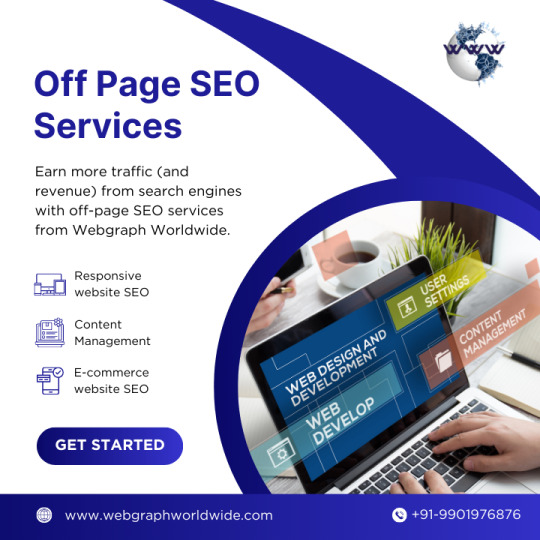
🚀 Boost Your Website's Authority with WebGraph Worldwide's Off-Page SEO Marketing Services! 🌐📈
Ready to strengthen your online presence and climb the search engine rankings? WebGraph Worldwide's Off-Page SEO Marketing Services are designed to enhance your website's authority and increase its visibility! 💪🔗
Our Off-Page SEO Marketing Services Include:
✅ High-Quality Backlink Building
✅ Content Promotion
✅ Social Media Outreach
✅ Online Reputation Management
✅ Increased Website Trust
✅ Competitive Edge
Don't let your website miss out on the off-page SEO advantages—let's make it a digital powerhouse! 🚀🌟
Ready to redefine your online presence? Contact us today!
📞 Call: +91-9901976876
💻 Visit: www.webgraphworldwide.com
Unlock the power of Off-Page SEO marketing now! 💰🔍
#WebGraphWorldwide#OffPageSEO#BacklinkBuilding#ContentPromotion#SocialMediaOutreach#OnlineReputationManagement#WebsiteAuthority#CompetitiveEdge#OnlineSuccess#WebGraphSolutions#OnlineGrowth#MarketingStrategy#WebGraphMagic#SEOGoals#DigitalTransformation#WebGraphStrategy#SEOExperts#OffPageSEOServices#SEOMarketing#OffPageSEOAgency#WebGraphSEO#SEOConsultants
0 notes
Text




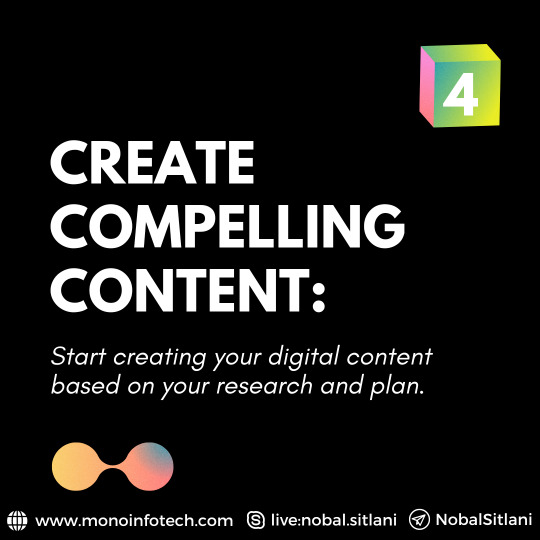
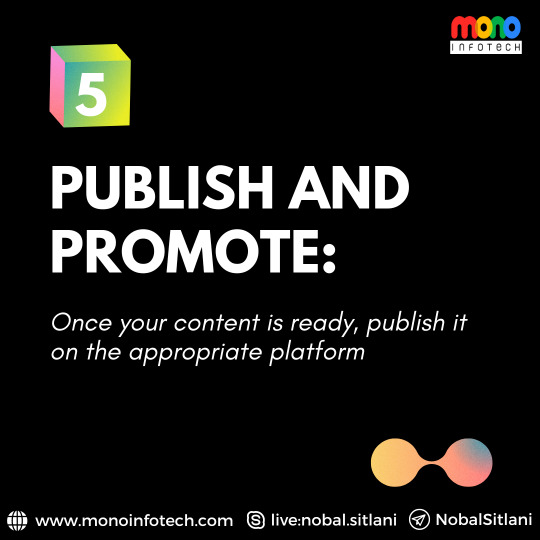

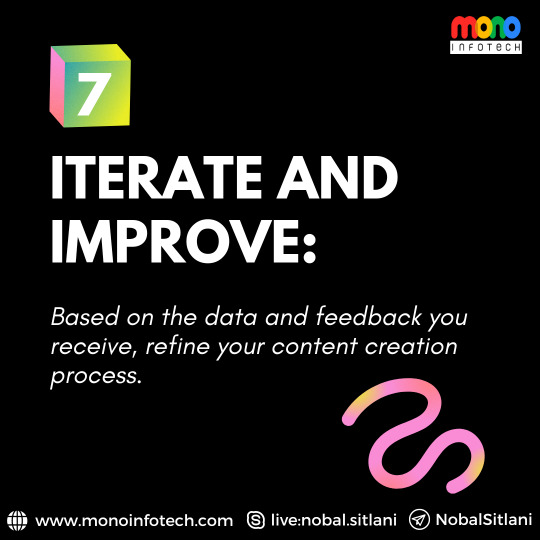
How to Create Engaging Digital Content?
Tips for a Successful #Strategy
1. - Define Your Goals - Determine the Purpose and Objectives of Your Digital Content
2. - Identify Your Target #Audience - Understand Who Your Content Is Intended for
3. - Choose the Right Format - Select the Most Suitable Format for Your Content.
4. - Create Compelling Content: Start Creating Your Digital Content Based on Your Research and Plan.
5. - Publish and Promote - Once Your Content Is Ready, Publish It on the Appropriate Platform
6. - Monitor and Analyze - Keep Track of How Your Content Performs.
7. Iterate and Improve - Based on the Data and #Feedback You Receive, Refine Your Content Creation Process.
#DigitalContent #ContentMarketing #OnlineMarketing #ContentCreation #DigitalStrategy #ContentCreators #ContentStrategy #DigitalMedia #ContentProduction
#DigitalContent#ContentMarketing#OnlineMarketing#ContentCreation#DigitalStrategy#ContentCreators#ContentStrategy#DigitalMedia#ContentProduction#ContentTrends#ContentPlanning#ContentDistribution#ContentCreatorsCommunity#DigitalPublishing#ContentTips#ContentIdeas#ContentWriting#VisualContent#ContentDesign#ContentPromotion
1 note
·
View note